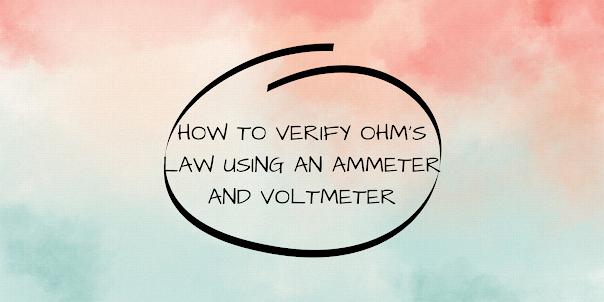To verify OHM’s law using an Ammeter and Voltmeter
 |
| How to verify OHM's law using an Ammeter and Voltmeter |
OBJECT:- To verify OHM’s law using Ammeter and Voltmeter
(A) APPARATUS REQUIRED
- Ammeter
- Voltmeter
- Accumulator
- Key
- Rheostat
- Given resistance wires
- Connecting wires
(B) THEORY:-
OHM’S Law states that at a constant temperature, the current flowing through any conductor is directly proportional to the potential difference at its ends.
i.e, I∝V
conversely
V∝I
or, V=IR——(1)
Where ‘R’ is proportionally constant known as the electrical resistance of the conductor.
The equation—(1) is identical to y=mx, which is an equation of a straight line passing through the origin with slope ‘m’. Hence, if we plot a graph ‘I’ and ‘V’ for a conductor wire, the result is a straight line passing through the origin. Then, ohm’s law is said to be verified. The slope of the straight line gives the value of resistance of the wire.
(C) OBSERVATION:-
Value of 10 divisions of voltmeter=0.5mv
or, the value of 1 division of voltmeter=0.05mv
Value of 10 division of ammeter=0.5mA
or, the value of 1 division of ammeter=0.05mA
OBSERVATION TABLE
| No. of observations | Ammeter Reading(I) | Voltmeter Reading (V) |
| i) | 0 | 0 |
| ii) | 2*0.05=0.1 | 4*0.05=0.2 |
| iii) | 3*0.05=0.15 | 6*0.05=0.3 |
| iv) | 4*0.05=0.2 | 8*0.05=0.4 |
| v) | 5*0.05=0.25 | 10*0.05=0.5 |
| vi) | 6*0.05=0.3 | 12*0.05=0.6 |
(D) CONCLUSION:-
The value of V/I is found to be sensibly constant. Also, the graph of ‘V’ against ‘I’ is found to be a straight line passing the origin. Hence, ohm’s law is verified.
May you also read: I Was My Own Route Exercise Class 12 English: Question Answers solutions
(E) PRECAUTIONS:-
- Connecting wires should be of appropriate length i.e, too long wire is not preferable.
- The length of the wire should be accurately measured.
- High current should not be passed.
- Reading should be taken carefully.
- Sensitive instruments should be used.